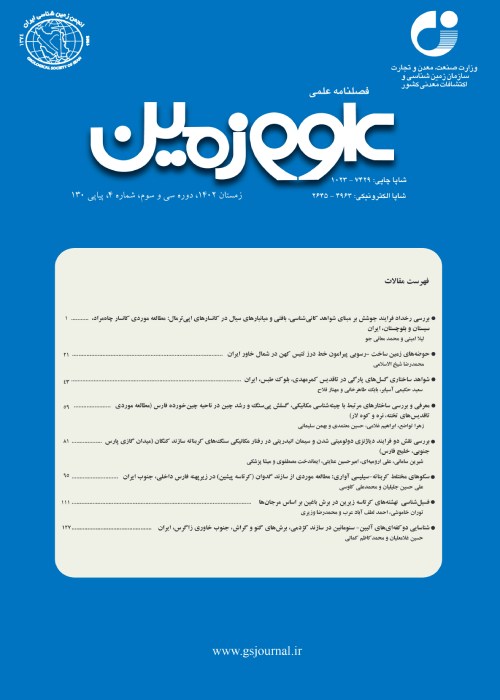The geological study of the origin of boron contamination in the Issiso springs, North of Urmia
Author(s):
Abstract:
Issiso hot springs are located 70 km of North of Urmia, within the northernmost part of the SanandajSirjan zone. The basement of study area is comprised by precambrian metamorphic rocks that consist of gneiss, schist and amphibolite are overlain by younger sediments. The boron concentration in the study area thermal waters is up to 451 mg/l. The warm waters of the region belong to the type of Na-(SO4)-HCO3. The Na/Cl ratio is more than 1 and B/Cl ratio is 0.37. It reflects the impact of specific geological phenomena in formation of rocks. Up to now there is no any geological study of the origin boron in this area. The main aim of this study is to determine geological factor(s) creating this high concentration which caused many environmental problems in the region. In this study it is determined that penetration meteoric water, heated by the deep intrusive magmatic bodies and then rises up with magmatic waters. At high levels, these waters collect in reservoirs including metamorphic host rocks and caused leaching of boron bearing mineral phases. The boron bearing water reaches the surface through faults. Part of the contamination water appears in the form of hot springs and another part through the faults caused spread contamination around the areas. This study shows that high boron contents in the Issiso thermal waters can be attributed to: 1) unstable boron bearing mineral phases same of muscovite, tourmaline, biotite and hornblende in the metamorphic rocks such as gneiss and mica schist, and 2) input of boron-bearing magmatic fluids, related to young volcanic activities. Due to the high temperature play a large role in leaching the boron the path rocks, it is estimated that high content of boron in Issiso springs may indicate the presence high potential of reservoirs of hot water in depths of earth and also the presence of rocks with high boron content in the path of rising waters.Middle Jurassic is determined for Dalichai Formation in Bar village section. Based on study of three main groups of phytoclasts, marine palynomorph and amorphic organic matter and result of statical studies on the different factors, sedimentary environment of Dalichai Formation in studied section was open marine basin with shallow and low oxygen condition.
Keywords:
Language:
Persian
Published:
Geosciences Scientific Quarterly Journal, Volume:25 Issue: 100, 2016
Page:
61
magiran.com/p1577537
دانلود و مطالعه متن این مقاله با یکی از روشهای زیر امکان پذیر است:
اشتراک شخصی
با عضویت و پرداخت آنلاین حق اشتراک یکساله به مبلغ 1,390,000ريال میتوانید 70 عنوان مطلب دانلود کنید!
اشتراک سازمانی
به کتابخانه دانشگاه یا محل کار خود پیشنهاد کنید تا اشتراک سازمانی این پایگاه را برای دسترسی نامحدود همه کاربران به متن مطالب تهیه نمایند!
توجه!
- حق عضویت دریافتی صرف حمایت از نشریات عضو و نگهداری، تکمیل و توسعه مگیران میشود.
- پرداخت حق اشتراک و دانلود مقالات اجازه بازنشر آن در سایر رسانههای چاپی و دیجیتال را به کاربر نمیدهد.
In order to view content subscription is required
Personal subscription
Subscribe magiran.com for 70 € euros via PayPal and download 70 articles during a year.
Organization subscription
Please contact us to subscribe your university or library for unlimited access!


